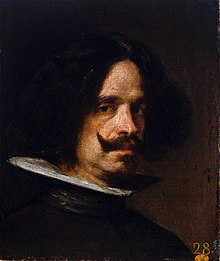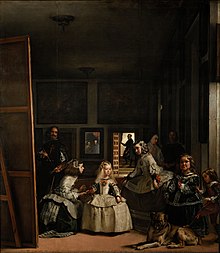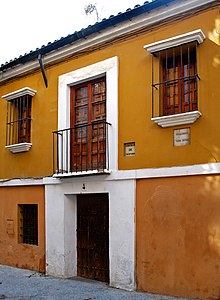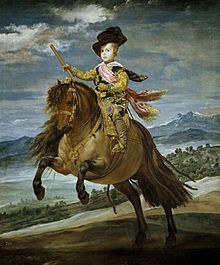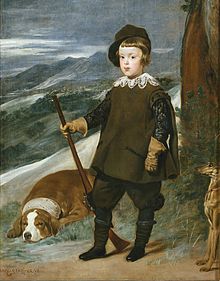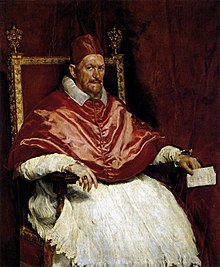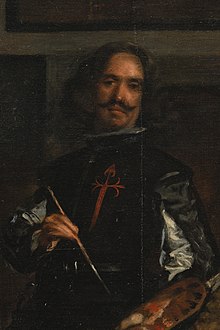Diego Velázquez
Diego Rodríguez de Silva y Velázquez (baptized June 6, 1599 in Seville , † August 6, 1660 in Madrid ), usually referred to as Diego Velázquez , was a Spanish Baroque painter who was one of the most important portrait painters of his time. As a painter at the court of the Spanish King Philip IV , he portrayed numerous members of the royal family and members of the court. Velázquez created numerous art-historically significant paintings. Probably the most famous painting by his hand is Las Meninas from 1656.
Since the early 19th century, Velázquez's work was a model for numerous painters, his paintings influenced, among others, Francisco de Goya and the impressionist Édouard Manet . 20th century painters such as Pablo Picasso , Francis Bacon and Salvador Dalí paid their respects to Velázquez by interpreting his paintings in a new way.
life and work
Family and name
Velázquez was probably born in Seville, Andalusia , in early June 1599. Only his christening date, June 6th, is certain. His father, Juan Rodríguez de Silva, was a lawyer of Portuguese descent whose parents had relocated from Porto to Seville almost twenty years before Velázquez was born . His mother Jerónima Velázquez came from a Hidalgo family from Seville. According to the customs of his time and his country, Velázquez, the eldest son, received his mother's surname. He started his apprenticeship as Diego Velázquez and as such he is also recorded in the church records on the occasion of his later wedding and the baptism of his two daughters. In contrast, he was accepted into the painters' guild under the name Diego Velázquez de Silva, and at the court in Madrid he occasionally used the name Diego de Silva y Velázquez . Today's art history usually refers to him simply as Diego Velázquez .
training
Seville was the largest city in Spain in Velázquez's time. It was also one of the country's intellectual and cultural centers and home to a number of painters. They not only supplied the churches of Seville and the wider area with paintings, but also created European works of art for the newly emerging churches and monasteries in Mexico , Argentina and Peru since the early 16th century . Therefore, a number of painting workshops existed in Seville, including those of his later teachers Francisco Herrera and Francisco Pacheco del Río .
Velázquez's upbringing included - as was the practice of his time - first an education in languages and philosophy. Due to his artistic talent, he began an apprenticeship with the painter Francisco Herrera at the age of ten. It is uncertain how long this training lasted with the teacher, who is considered to be very emotional. What is more certain, however, is that he continued his apprenticeship in the workshop of Francisco Pacheco del Río from December 1, 1610. Pacheco is now classified as an unremarkable painter, but his painting occasionally shows a simple, realistic style that was in marked contrast to the paintings of Raphael . Pacheco was also an excellent art theorist. In the five years that Velázquez stayed with Pacheco, he mainly learned the use of proportions and perspective . Velázquez's training was significantly influenced by the works of Caravaggio , whom Pacheco valued as an outstanding painter and of whose work Velázquez studied several paintings in the original or as copies during his apprenticeship.
First work as a freelance artist
In 1618 Velázquez married his daughter Juana with Pacheco's consent and began to work as an independent artist. Nature was a great role model for the young artist. He painted from the living model and thus developed into the greatest naturalist of the Spanish school. Portrait painting became one of the main focuses of his work . Among his earliest works are portraits of individuals and groups from popular life, the so-called bodegones . Under Bodegón is understood to still lifes and kitchen items Spanish painter, which in contrast to the still lifes of their Dutch treat equivalent contemporaries people and things and are far decked reserved. These include the water seller of Seville , a picture that is characterized by an uninhibited naturalness of conception and freedom of painterly treatment, as well as the painting Vieja friendo huevos , in which an old woman is shown frying eggs. The strong contrasts of light and dark colors are an unmistakable indication of the stimuli from Caravaggio's work. Two naturalistic religious images also fall during this period: The Adoration of the Magi (1619, Prado , Madrid) and The Adoration of the Shepherds ( National Gallery , London).
Velázquez had already gained a great artistic reputation in Seville at the beginning of the 1620s. At the same time he became a father - his wife bore him two daughters. The younger daughter died as a toddler, the older daughter Francisca later married the painter Bautista del Mazo .
Madrid and Philip IV

First stay at the farm
In the second half of April 1622, Velázquez went to Madrid . It is unclear whether he already did so with the aim of getting a job as a court painter there. There is evidence that he wanted to see the masterpieces exhibited there in El Escorial . The Spanish court was under the reign of Philip IV, who had sat on the throne for a year and was almost 17 years old. From his father Philip III. he had taken on four court painters: Rodrigo de Villandrando , Bartolomé González , Eugenio Caxés and Vicente Carducho . All four painters were influenced to varying degrees by Caravaggio's naturalism. Carducho and Caxés were still most closely associated with Mannerism , which was of great importance in Spain in the last quarter of the 16th century. While Carducho is now considered the most important of these four painters, the young Philip IV particularly appreciated Villandrando, who portrayed him and his wife Isabella von Bourbon several times. Historiography classifies Philip IV as a rather insignificant monarch. However, he was an art lover and prided himself on having a reputation as a painter and poet.
The affairs of state of the Spanish court were carried out by Count Olivares , who probably knew the work of Velázquez from a stay of several months in Seville. Another supporter of Velázquez was Juan de Fonseca , canon of Seville Cathedral and chaplain to the young king. Velázquez was initially not given an opportunity to portray the king or queen, but caught the attention of the Spanish court with a portrait of the Spanish poet Luis de Góngora .
The call to the royal court
In December 1622, Villandrando, who was valued by Philip IV, died, and in the spring of 1623 Velázquez was called to Madrid at Olivares' initiative. Juan de Fonseca quartered the young painter and gave him a portrait. The admiration this portrait aroused at court finally gave Velázquez the opportunity to paint Philip IV. The portrait of Philip IV, on the basis of which the artist was appointed royal painter, has been preserved in an overpainted version. It shows a sensitive, non-idealized image of the king who exudes royal dignity despite a renunciation of the usual insignia of power.

On October 6, 1623, Velázquez entered the service of the Spanish king as court painter. Velázquez was given a studio in the royal palace and, in 1624, the sum of 300 ducats from the royal box to finance his family's move to Madrid. His monthly salary was 20 ducats and accommodation as well as additional remuneration for all the paintings he made.
Philip IV quickly recognized Velázquez's extraordinary talent and declared that no other painter should carry out his portraits - a statement that did not last long, however, because Peter Paul Rubens painted several portraits of the Spanish king. In 1625, Velázquez created a now lost equestrian portrait of Philip IV, which allowed him to rise even further in the hierarchy of court painters. In gratitude, Velázquez received 300 ducats from the king and the same amount as an annual pension for life. Two portraits of Philip IV still hang in the Prado today, showing that Velázquez's painting style had softened compared to the paintings of the Seville era. Velázquez's reputation as an excellent portrait painter rose very quickly, so that the later English King Charles I also sat as a model during a stay at the Spanish court Velázquez. Unfortunately this painting has also been lost. The success of Velázquez was not seen without envy by the three other court painters. Carducho, in particular, repeatedly mocked Velázquez's style in his writings on art theory.
In 1627, the Spanish king initiated a painting competition among his four court painters, and the subject of the competition was the expulsion of the Moors from Spain. The sick Bartolomé González was represented in this competition by Angelo Nardi . Philip IV appointed the painter Juan Bautista Maíno and the architect Giovanni Battista Crescenzi to the jury . Velázquez 'competition entry was a painting that Philip III. showed, who with his marshal's baton shows a group of people the way out of Spain. Both jury members declared Velázquez the clear winner of the competition, and Philip IV confirmed their decision. As a reward for his victory, Velázquez was appointed chamberlain . For Velázquez this meant a rent-free apartment in the palace, free medical treatment and free medicine. Velázquez had thus acquired a clear primacy among the four court painters.
Rubens at the Spanish royal court
In 1628 Peter Paul Rubens was a guest in Madrid for nine months, and the Spanish king commissioned Velázquez to familiarize him with the art of Spain. Rubens was at the height of his fame by this point, and Pacheco, possibly partisan as Velázquez's father-in-law, proudly made the claim that Rubens was talking to no other artist than his son-in-law. The encounter with Rubens had no influence on Velázquez's painting style, but Rubens encouraged Velázquez to see the great works of Italian painters in Italy.
The first trip to Italy
In 1629 Philip IV granted Velázquez paid leave, enabling him to visit Italy. In August 1629 he sailed in the entourage of the Marqués de Spinola , who was to take command of the Spanish troops standing there in Milan. During this trip, Velázquez must have heard details of the surrender of Breda from the then commanding officer of the Spanish Army and made a first portrait study for his later history painting of the surrender of Breda .
In Venice he made copies of Tintoretto's paintings Crucifixion and Last Supper and sent them to the Spanish royal court. In Rome he made copies of the works of Raphael and Michelangelo . During his stay in Italy, where he stayed until the beginning of 1631, he created, among other things, the two history paintings The Sons of Jacob bring Joseph's bloody skirt (El Escorial, Madrid) and Apollo in the forge of the volcano (Prado). Both paintings show the influence of the Italian masters.
In the painting Apollo in the forge of the volcano , Velázquez captures the moment when the radiant youthful Apollo enters the forge and announces to the god Vulcan that his wife Venus has fled with the god of war Mars. Surprised by Apollo's entry, the volcano's assistants remain in Poznan, which clearly shows the influence of the Italian painters. The shape of the brushwork and the red tone of Apollos' tunic also point to the influence of Tintoretto and Titian . In The Sons of Jacob bring this bloody skirt to Joseph , the action takes place in an open hall, the floor of which consists of a checkerboard pattern popular with Tizian and Tintoretto. The sons of Jacob are also barked by a little dog, as it often appears with Tintoretto.
Velázquez escaped the summer heat of Rome for two months in the Villa Medici , where he studied works of art from the ancient world. Probably there were two landscape studies that, due to their brushwork, look like impressionist paintings from the late 19th century. Via Naples, where he met his compatriot, the painter Jusepe de Ribera , in 1631 , he returned to Spain.
Return to Madrid
In Madrid he was commissioned by Philip IV to create countless portraits of members of the Spanish royal family and the Spanish court. The large number of paintings that Velázquez created after his return were only possible thanks to an efficient workshop in which his son-in-law Juan Bautista Martínez del Mazo also worked since 1633 . Mazo had married Velázquez's only fourteen-year-old daughter Francisca that year.
In the twenty years that passed before his second trip to Italy, his reputation at the royal court was consolidated. The artistic design of numerous buildings of the Spanish king was entrusted to him. In 1634/35 he created a series of paintings for the large state hall in the new royal palace "Buen Retiro" in Madrid and in 1636 added hunting portraits and portraits of dwarves and court jesters to the Torre de la Parada hunting pavilion, which was furnished with numerous pictures from Rubens' workshop . The growing appreciation that Velázquez experienced is also expressed in his rise within the court hierarchy. In 1636 the king appointed the court painter to ayuda de guardarropa , an assistant in the cloakroom without a salary . In 1643 Velázquez was allowed to adorn himself with the title Chamberlain of the Private Rooms. In the same year he was appointed assistant to the superintendent for special building projects.
Portraits of Prince Baltasar Carlos
Among those portrayed by him was the heir to the throne, Prince Baltasar Carlos . The paintings that Velázquez created are among the most beautiful child portraits of the Baroque.
Prince Baltasar Carlos and his dwarf , which was created immediately after Velázquez's return from Italy, shows a nearly two-year-old toddler in the center of the picture in a splendid ceremonial dress, which already exudes royal dignity with its finely modeled head. Rapier, command staff and the ruffled wine-red curtain in the background indicate that the long-awaited successor of Philip IV is depicted here. The dwarf's head, on the other hand, is much coarser. It is equipped with a silver children's rattle and an apple like a scepter and orb , as if it were playing the bizarre master of ceremonies for the toddler.
Five years later Velázquez portrayed the heir to the throne on a rearing horse. Velázquez again gave the child, now depicted in the uniform of a field marshal, dignity and seriousness. While the background of the picture is only hinted at, the face of the heir to the throne is bathed in light. Even the shadow cast by the brim of the hat of the heir to the throne is transparent. The young prince looks down at his viewer with tired nobility that contradicts the childlike nature of the sitter. Most of the portraits that Velázquez made of the young prince, who presumably died of appendicitis in 1646 , show him as a child dominated by the role constraints of his position. An exception is the painting Prince Baltasar Carlos as a hunter from 1635/1636 , which was created as a counterpart to the painting Philip IV as a hunter . Depicted is a child who looks carefully at the viewer and has a chicken dog dozing at his feet, while the blue-green grass appears to be damp from the dew. Here only the rich clothing of the six-year-old indicates the role he has been assigned.
The portraits of court dwarves and jesters
The portraits of the court dwarves and fools of the royal court that Velázquez painted in the twenty years up to his second trip to Italy also radiate dignity and seriousness .
The foolish servants who belonged to the Spanish court were divided into three groups: The task of the truhanes , the court jesters, was to entertain the court with witty ideas. One of them was, for example, the court jester Pablo de Valladolid , portrayed by Velázquez in 1632/35 , whom he portrayed in the declamatory gesture of an actor and whose picture 230 years later inspired Édouard Manet for his painting The Tragedy . The second group of the foolish servants were the small stature, who were amused at court because of their disproportionate body and who were often assigned to the royal children as playmates. That is why they appear in numerous paintings by the royal family. For her individual portraits, such as Sebastián de Morra , Velázquez often chose the format of a low rectangle. Art historians have occasionally seen this compact format as Velázquez's attempt to artistically reproduce the narrowly circumscribed world of the court dwarfs. However, this format may also have been determined by the fact that these paintings were intended for furnishing the royal hunting pavilion.
The third group of foolish servants were people with deformities or mental disabilities, which were then called nature games . They too should amuse the court when they unexpectedly and unsuspectingly got into strange situations. Velázquez also depicted them in several paintings. These include the portrait The Child of Vallecas , which shows the roughly 15-year-old physically handicapped and mentally retarded Francisco Lezcano playing with cards, and the painting Court Jester Calabazillas , which is artistically so mature and balanced that art historians long consider it to be his later work Velázquez '. Like almost all portraits of the foolish servants, this picture is not dated. Only on the basis of accounts of the court, which showed that the court jester Juan Calabazas died in 1639, the date of creation of this picture is dated back to the period from 1637 to 1639.
Velázquez refrained from caricaturing the portrayed, but instead painted them with the same powers of observation and the same emotional sensitivity as the members of the Spanish nobility. These paintings in particular inspired painters such as Francisco de Goya , Édouard Manet , Pablo Picasso and Salvador Dalí to reinterpret the work of Velázquez. Dalí, for example, created a painting based on the painting by Don Sebastián de Morra in 1982, which again depicts the court jester, and named it Behind the window on the left, where a spoon comes out, Velázquez is dying .
The equestrian portraits

One of the masterpieces that Velázquez created during this period is the equestrian portrait of Conde-Duque de Olivares on horseback from 1634. The powerful minister was the painter's early and long-standing patron, and we know his immobile face from many of Velázquez's paintings. Velázquez had remained loyal to this man after falling out of favor at the royal court. This famous painting depicts Olivares as a field marshal with a plumed hat, gold-trimmed breastplate and command staff. His chestnut horse bursts into battle, while he himself looks haughty down at his viewer. It is a representation that was normally only granted to ruling rulers.
The equestrian portrait of Conde-Duque de Olivares was created to furnish the Salón de Reinos (Salon of the Kingdoms) in the new Buen Retiro Palace . Two paintings by Titian and Rubens, each depicting Philip II and Charles V on horseback, were to hang in this salon . Velázquez revised the equestrian portraits of Philip III created by unknown painters . and Queen Margaret of Spain, the parents of Philip IV, as well as the equestrian portrait of Isabella von Bourbon, the wife of Philip IV.
With the painting Philip IV on horseback , Velázquez created the picture that, due to the rank of the portrayed, represents the most important work in this cycle. It shows the king and his horse in profile position without any allegorical accessories in front of a gently sloping and expansive ideal landscape painted in shades of gray and blue, while the horse and rider perform the crank , a rider figure with the horse rising and that of the rider demands maximum concentration. In this reduced pictorial rhetoric, Velázquez again clearly differs from his contemporary Rubens, who regularly emphasized the importance of those he portrayed by either depicting them exaggeratedly large against a deep horizon or by staging his pictures more strongly through battle scenes or allegorical figures. Of the numerous equestrian portraits that Velázequez created of Philip IV, one served the sculptor Montafles as a model for a bronze statue that is now in the Plaza del Oriente in Madrid.
The handover of Breda
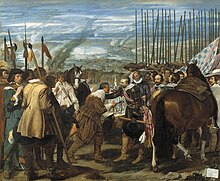
Similar to the equestrian portrait of Philip IV on horseback , Velázquez also dispensed with any allegorical or mythological accessories in the painting Transfer of Breda and focused on the moment when on June 5, 1625 the defeated Dutch passed the Marqués de Spinola , the leader of the Spanish Army hand over the keys to the city of Breda after almost a year of siege . Because of the concentration on the pure representation of this historical moment, The Handover of Breda is regarded as the first pure historical picture of modern European painting. It is one of their highlights and is considered by many art historians to be one of the most perfect war paintings.
The city of Breda was the most important fortress of the southern Netherlands in Brabant . The conquest of this fortress was a decisive step in the protracted struggle for the Netherlands , which decided Spain's future position as a world power. Spinola, Philip's most successful general in the Eighty Years' War , granted his opponents generous gestures of surrender under the leadership of Justinus von Nassau . This included that the defeated army was allowed to leave the city of Breda with flags and weapons. He was praised by many Spaniards for this generous gesture, and Velázquez managed to capture Spinola's behavior in this painting. In a noble gesture, Spinola receives the underdog and knightly lays his hand on his shoulder, ignoring the humbly offered key to the city gates.
The second trip to Italy and death
At the end of 1648 Velázquez went to Italy for the second time to purchase works of art on behalf of the king as models for an art academy to be founded in Madrid . He stayed in Italy until June 1651, where he created, among other things, a portrait of Pope Innocent X , which is one of the best portraits of the Pope ever painted. Returning to Madrid, Velázquez felt compelled to intensify his activities as a court painter because of the second marriage of the Spanish king to Maria Anna of Austria . He was also appointed court marshal. In addition, however, he also found time to paint a religious picture such as the visit of the holy abbot Antonius to the holy hermit Paul in the desert and three masterpieces of the first order: The carpet weavers , a picture that depicts the fable of Arachne , Venus in front the mirror , his only act , and the painting known as Las Meninas (The Ladies in Court) , which shows Velázquez himself painting the royal family (all Prado except Venus, National Gallery ).
His grueling activity in the service of the king was not without its effects on his health. He contracted a "hot fever" from which he died on August 6, 1660 in Madrid. Velázquez was born the following day in the Parish Church of St. John (Iglesia Parroquial de San Juan) , one block from the Royal Palace in Plaza de Ramales ( 40 ° 25 ′ 1.4 ″ N , 3 ° 42 ′ 41.5 ″ W ), to bury. Around 1809, on behalf of Joseph Bonaparte , the then ruler of Spain and older brother of Napoleon Bonaparte , the church was closed to create a square. The bones of Velázquez have since disappeared; later excavations since the middle of the 19th century, especially in the Velázquez year 1999, have not been able to clarify their whereabouts.
Characteristics of Velázquez's painting
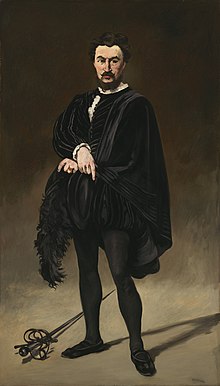
Velázquez is one of the greatest portrait painters of all time, who, in addition to the idealistic conception of art that prevailed at the time, also elevated naturalism to a style of equal standing. His highest aim was the strictly objective imitation of nature with a witty and individual conception. This is why his style exerted a great influence on the painting of the second half of the 19th century, which was related to him. Édouard Manet, for example, created his painting The Tragedy under the influence of Velázquez's painting Jester Pablo de Valladolid . Both are shown in a peculiarly indeterminate space without a floor line and are similar in their foot position.

Velázquez's painting style has undergone various transformations: from a kräftig- pasty , warm color with brownish shade starting, he gradually learned the action of natural daylight to the color of the figures and objects know. Finally, he wrapped all the local colors in a cool, gray tone, which characterizes his most mature creations. In his last works, he resolved the depicted motifs into single, lightly applied brushstrokes, which only grow together when viewed from a greater distance to form a unified whole of closed harmony. In his late work he therefore came very close to the conception that became predominant in Impressionism.
A year before his death, Velázquez created the portraits of Infanta Margarita Teresa in a blue dress and that of her little brother Philipp Prosper as his last completed works. The painter's personal style reached its climax in these paintings. Flickering spots of color create an almost impressionistic effect on wide painting surfaces. Only at an appropriate distance does the viewer get the impression of closed plasticity. In the same year the pictures were sent to Vienna as a present to Emperor Leopold I, who married the Infanta in 1666.
Velázquez's portrait of Infant Philipp Prosper is the only one that has survived. As in all of the artist's later paintings, his use of colors is extraordinarily fluid and lively. From this portrayal of the tender and sickly son of King Philip IV speaks the hope that was placed in the then only heir to the Spanish crown. Fresh red and white contrast with the morbid colors of late autumn. A small dog looks questioningly at the viewer through oversized eyes, and the spacious, pale background also suggests a gloomy fate - the little prince died at the age of four.
reception
Art historians divide Velázquez's oeuvre into three periods, based on the artist's two trips to Italy (1629 to 1631 and 1649 to 1651), which are seen as turning points. This classification is in part arbitrary because it does not consistently correspond to Velázquez's artistic development. As with many other artists, Velázquez's life's work has a variety of styles. A reliable classification into the three creative periods is also made difficult by the fact that he rarely signed and dated his works. The Spanish Royal Archives only recorded the completion dates of the most important works.
Museums with paintings by Velázquez
The museum with by far the most important and extensive collection of Velazquez paintings is the Prado in Madrid, which goes back to the collections of the Spanish kings. Other museums in Spain can show individual Velazquez works. Other important works can be seen in England (especially in the National Gallery (London) ) as well as in the USA (especially in the Metropolitan Museum of Art ). In the German-speaking countries, the late portraits of princes and princesses in the Kunsthistorisches Museum , which came to Vienna during their lifetime, should be mentioned in particular . In addition, the museums in Berlin , Dresden and Munich own some important Velazquez works.
Works (selection)
Unless otherwise stated, these are paintings on canvas.
The table can be sorted by columns (e.g. by dates or locations) (click on the header).
| image | title | year | Dimensions | collection |
|---|---|---|---|---|

|
The old woman frying eggs | 1618 | 105 × 119 cm | Edinburgh, Scottish National Gallery |

|
The Adoration of the Magi | 1619 | 203 × 125 cm | Madrid, Prado Museum |

|
Portrait of Gaspar de Guzmán, Duke of Olivares . ( Gaspar de Guzmán, Conde de Olivares ) | 1624 | 203 × 106 cm | Sao Paulo, Museu de Arte de Sao Paulo |

|
The Drunkards or The Triumph of Bacchus | 1629 | Madrid, Prado Museum | |

|
Portrait of the Infanta Maria of Austria | 1628 approx. | 58 × 44 cm | Madrid, Prado Museum |

|
Apollo in the forge of Vulcan | 1630 approx. | 223-290 cm | Madrid, Prado Museum |

|
Don Pedro de Barberana as a member of the Calatrava Order | 1631-32 | Fort Worth, Texas, Kimbell Art Museum | |

|
Philip IV in a brown and silver costume | 1632 | London, National Gallery | |
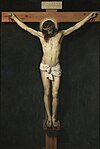
|
Christ on the cross. From the Benedictine monastery church of St. Plácido in Madrid. | 1632 | 248 × 169 cm | Madrid, Prado Museum |

|
Prince Baltasar Carlos on horseback | 1634-35 | 209 × 173 cm | Madrid, Prado Museum |

|
Philip III on horseback | 1628, 1634 | Madrid, Prado Museum | |

|
The surrender of Breda (Las Lanzas)
see individual article on the painting: The Surrender of Breda |
1635 | 307 × 370 cm | Madrid, Prado Museum |

|
The Cardinal-Infante Don Fernando de Austria | 1634-36 | Madrid, Prado Museum | |
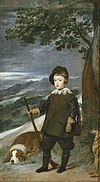
|
Portrait of Prince Baltasar Carlos as a hunter | 1635-36 | Madrid, Prado Museum | |
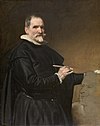
|
Juan Martínez Montañés | 1635-36 | 109 × 88 cm | Madrid, Prado Museum |

|
Prince Baltasar Carlos with the Duke of Olivares | 1636-37 | 144 x 96.5 cm | London, Collection of the Duke of Westminster |
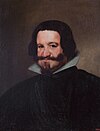
|
Duke of Olivares | 1638 | Saint Petersburg (formerly Leningrad), Hermitage | |

|
The Greek fable poet Aesop, probably part of a series of paintings for the royal hunting lodge Torre de la Parada near Madrid | 1639-1640 | 179.5 × 94 cm | Madrid, Prado Museum |
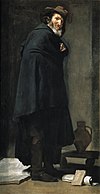
|
The Greek poet Menippos of Gadara , probably part of a series of paintings for the royal hunting lodge Torre de la Parada near Madrid | 1639-41 | 178 × 93.5 cm | Madrid, Prado Museum |

|
Coronation of Mary | 1641-44 | 178.5 x 134.5 cm | Madrid, Prado Museum |

|
The court jester Don Sebastián de Morra | 1643-45 | Madrid, Prado Museum | |
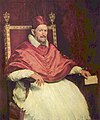
|
Innocent X. | 1650 | 140 × 120 cm | Rome, Galleria Doria |

|
Portrait of Juan de Pareja | 1650 | 81.3 x 69.9 cm | New York, Metropolitan Museum of Art |

|
Infanta Maria Teresa (1638–1683) | 1652-53 | 127 × 99 cm | Vienna, Art History Museum |

|
The maids of honor ("Las Meninas", The Infanta Margareta in Velazquez's studio)
see individual article for the painting: The court maids |
1656 | 318 × 276 cm | Madrid, Prado Museum |

|
The saga of the Arachne (The Spinners, Las Hilanderas)
See the single article The Spinners for this painting |
1658 approx. | 220 × 289 cm | Madrid, Prado Museum |
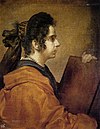
|
Sibylle | 1630 | Madrid, Prado Museum | |

|
Christ in the house of Mary and Martha | 1618 | 63 cm × 103 cm | London, National Gallery |

|
The lady with the fan
see the single article The lady with the fan for this painting |
1638-1639 | 93 × 69 cm | London, Wallace Collection |

|
Venus in front of the mirror
See the single article Venus in front of the mirror for this painting |
1647-1651 | 122.5 x 177 cm | London, National Gallery |

|
Portrait of King Philip IV of Spain | 1628 (at the latest) | 198 cm × 102 cm | Madrid, Prado Museum |

|
Prince Baltasar Carlos and his dwarf | 1631/32 | 128.1 cm x 102 cm | Boston, Museum of Fine Arts |

|
The court dwarf Don Diego de Acedo "El Primo" | 1644 | Madrid, Prado Museum | |
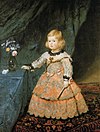
|
Infanta Margarita Teresa (1651–1673) in a pink dress | 1654 | 128.5 cm × 100 cm | Vienna, Art History Museum |

|
Infanta Margarita Teresa (1651–1673) in a blue dress | 1659 | 127 cm × 107 cm | Vienna, Art History Museum |

|
Infant Philipp Prosper (1657–1661) | 1659 | 129 cm × 99 cm | Vienna, Art History Museum |
Exhibitions
- 2014/2015: Velázquez , Kunsthistorisches Museum , Vienna. Catalog.
Movies
Diego Velázquez, court marshal and painter, BR 1999, a documentary by Bernhard Graf
literature
- Sylvia Ferino, Sabine Haag (ed.): Velázquez. Hirmer, Munich 2014, ISBN 978-3-7774-2313-5 .
- Wolf Moser: Diego de Silva Velázquez. The work and the painter. 2 volumes. Edition St. Georges, Lyon 2011, ISBN 978-3-00-032155-9 .
- Jonathan Brown: Collected Writings on Velazquez. Yale University Press 2008, ISBN 978-0-300-14493-2 .
- Richard Muther: Diego Velázquez. ABOD, 2006, ISBN 3-8341-0179-6 .
- Wolf Moser: The Velázquez case. Reply. Allitera Verlag, Munich 2005, ISBN 3-86520-138-5 .
- Martin Warnke : Velázquez. Form and reform . Dumont Literature and Art Verlag, Cologne 2005, ISBN 3-8321-7642-X .
- Jonathan Brown: Velazquez: The Technique of Genius. New edition. Yale University Press, 2003, ISBN 0-300-10124-4 .
- Norbert Wolf: Velázquez. Benedikt Taschen Verlag, Cologne 1999, ISBN 3-8228-6376-9
- José Lopez-Rey: Velázquez. Painter the painter. Catalog raisonné. 2 volumes Cologne 1996, ISBN 3-8228-8723-4 .
- Walther Gensel, Velazquez, The Master's Painting. German publishing house, Stuttgart and Leipzig, 1905.
- Carl Justi : Diego Velázquez and his century. [1903]. Leipzig 1983, DNB 840089074 .
- José López-Rey, Odile Delenda: Veláquez. The complete work . XXL or XL edition, TASCHEN, Cologne 2020, ISBN 978-3-8365-5013-0 / 978-3-8365-8175-2
Web links
- Literature by and about Diego Velázquez in the catalog of the German National Library
- Works by and about Diego Velázquez in the German Digital Library
- Works by Diego Velázquez at Zeno.org .
- Diego Velázquez at artcyclopedia.com (engl.)
- Diego Velázquez at the School of Seeing , cooperation project between the Universities of Berlin (FU), Bern, Dresden, Hamburg, Marburg and Munich
- Diego Velázquez - the five most expensive works
Individual evidence
-
^ Al Goodman (September 7, 1999). Arts Abroad. A Furor for Velazquez: His Art but Also His Bones. New York Times (accessed October 28, 2008)
Ysabel de la Rosa (August 23, 1999). Letter from Madrid. (Section: "Where's the body?"). artnet.com (accessed October 28, 2008) - ^ Kunsthistorisches Museum, Vienna "Infanta Margarita Teresa (1651–1673) in a blue dress | Diego Rodríguez de Silva y Velázquez | 1659 | Inv. No .: GG_2130" ( Memento from November 1, 2013 in the Internet Archive )
- ^ Kunsthistorisches Museum, Vienna "Infant Philipp Prosper (1657–1661) | Diego Rodríguez de Silva y Velázquez | 1659 | Inv. No .: GG_319" ( Memento from October 26, 2014 in the Internet Archive )
| personal data | |
|---|---|
| SURNAME | Velazquez, Diego |
| ALTERNATIVE NAMES | Silva y Velázquez, Diego Rodríguez de; Velázquez |
| BRIEF DESCRIPTION | Spanish painter |
| DATE OF BIRTH | baptized June 6, 1599 |
| PLACE OF BIRTH | Seville |
| DATE OF DEATH | August 6, 1660 |
| Place of death | Madrid |
